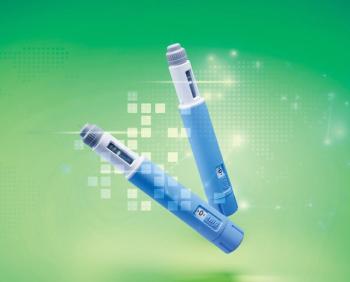
Diabetic Polyneuropathy: Definitive Diagnosis
Diabetic polyneuropathy (DPN) has a major impact on quality of life and can contribute to significant morbidity and mortality. In the United Kingdom, the prevalence of distal symmetrical polyneuropathy, as seen in specialty care, is about 28.5%, and prevalence increases with age.
Diabetic polyneuropathy (DPN) has a majorimpact on quality of life and can contributeto significant morbidity and mortality. In theUnited Kingdom, the prevalence of distal symmetricalpolyneuropathy, as seen in specialtycare, is about 28.5%, and prevalence increaseswith age.1
DPN can present with a wide range of symptoms, including pain, unsteadiness, weakness, postural hypotension, gastroparesis, and impotence. It can lead to foot ulceration, Charcot foot, and amputation. It is desirable to periodically assess for the presence of neuropathy and also stratify neuropathy in patients in anticipation of these problems.
It is important to be aware of the strengths and limitations of the different tests used to assess DPN and their abilities to demonstrate a meaningful change in peripheral neuropathy. Also, because not all patients with an abnormality will show clinically significant disease, it is important to know to what degree the test results are altered from normal.2
CLASSIFICATION OF DIABETIC NEUROPATHY
Diabetic neuropathy can be classified as acute sensory and chronic sensorimotor.
Acute sensory neuropathy. Acute sensory (painful) neuropathy is distinguished from chronic sensorimotor neuropathy by the mode of onset, accompanying signs, and prognosis (Table 1).3,4 Severe pain is the main complaint and is often associated with significant weight loss and depression and erectile dysfunction in men.
The patient complains of a constant burning discomfort in the feet with severe hyperesthesia; deep aching pain; and sudden, sharp, stabbing, or electric shock- like sensations in the lower limbs with nocturnal exacerbation and bedclothes allodynia. Clinical examination is usually unremarkable, allodynia may be confirmed on sensory testing, findings from the motor examination are normal, and occasionally the ankle reflexes are reduced.
Poor glycemic control is associated with acute painful neuropathy and may follow ketoacidosis or sudden improvement in glycemic control with insulin or oral hypoglycemic agents.5 Degeneration of both myelinated and unmyelinated nerve fibers has been found in sural nerve biopsies from patients with acute painful neuropathy.6,7 Both small and large fibers are involved in acute painful neuropathy, but damage to small fibers predominates, explaining the lack of abnormality in clinical testing.8
In regard to cause, in vivo epineurial vessel photography and fluorescein angiography of the sural nerve have demonstrated arteriovenous shunting and proliferating new epineurial vessels in patients with acute painful neuropathy associated with sudden improvement of glycemic control.9 A major difference between this and chronic sensorimotor neuropathy is an acute or subacute onset with resolution of severe symptoms within 1 year.6
Chronic sensorimotor neuropathy. Both patients with type 1 and those with type 2 diabetes may present with chronic sensorimotor neuropathy. This is the most common form of diabetic neuropathy.6,10 The course is chronic and progressive. Up to 50% of patients may be asymptomatic. The feet and lower limbs are most commonly affected, and there may be nocturnal exacerbation. Symptoms include pain and paresthesias that are intermittent and less severe than in acute painful neuropathy; negative symptoms such as numbness and unsteadiness may also be present.
Examination shows a symmetrical decrease or loss of all modalities in a stocking distribution that may extend above the ankle and, in severe cases, the hands also may be involved. Knee and ankle reflexes are usually reduced or absent.
In more advanced cases, small muscle wasting in the feet and hands may be seen, although motor weakness is highly unusual. Any pronounced motor signs should raise the possibility of a nondiabetic cause of the neuropathy, especially if the signs are asymmetrical.11,12
Distal sympathetic autonomic neuropathy also may accompany chronic sensorimotor neuropathy13 and may be characterized by anhidrosis. Deformities are often present in advanced disease; however, the absence of obvious foot deformity does not exclude the risk of ulceration.14
The diagnosis of chronic sensorimotor neuropathy cannot be made using symptoms alone and must incorporate a careful neurological examination. An international consensus from the neuropathy study group of the European Association for the Study of Diabetes has proposed an annual review that includes a detailed history and examination of the foot, including assessment of the skin, joints, ankle reflexes, gait, and footwear and evaluation of peripheral sensation to pinprick, light touch, vibration, and pressure.11
The assessment should include:
- Patient history, including age, type and duration of diabetes, and ongoing treatment.
- Review of patient risk factors, including those related to glycemic control, blood pressure, and lipid measurements.
- Physical factors, such as inability to see well or reach the feet.
- Lifestyle habits, including cigarette smoking, alcohol intake, nutrition, employment, sport/leisure activities, and footwear.
- Social circumstances, including socioeconomic status, mobility, social support, and access to care.
- Symptoms, including presence/ absence of symptoms, nature of symptoms (ie, positive or negative), duration and progression of symptoms, and presence of nocturnal exacerbation.
In patients with chronic pain, ask whether the pain is insidious, intermittent, or bilateral; whether it is related to treatment; and whether it occurs on walking or at rest. Also inquire about the patient's history of foot ulcers and of the presence of autonomic symptoms. In patients with acute pain, ask about the presence of contact hyperesthesia.
In many cases, symptoms are the main impetus for patients to seek help and bring DPN to medical attention. This means that symptoms that are mild or transient tend not to be voluntarily spoken about, unless the clinician asks. Going through a checklist of symptoms using a simple symptom screening questionnaire may be useful. A wide range of questionnaires is available to assess quality, severity, and progression with time. Some of the scores designed for clinical trials may be useful in clinical practice.1,2
A check list of symptoms, visual analog scales, graphic rating scales, the total symptom score, and neuropathy symptoms and change score are examples of such scoring systems.2,15,16 A number of scoring scales also have been developed to assess the impact on quality of life, one of which is the NeuroQol, a validated instrument for assessing the effect of diabetic neuropathy on the patient's quality of life.17
It is also important to obtain a history of other medical conditions and therapies that may cause neuropathy: vascular disease, HIV infection, vitamin B12 deficiency, hypothyroidism, weight loss, cancer, leprosy, syphilis, drug therapy, toxin exposure, paraproteinemia, and so on. Features that are usually related to causes other than neuropathy include rapid progression, motor deficits, back or neck pain, weight loss, and a family history.
THE EXAMINATION
- Inspection of the feet. The patient should be asked to remove shoes and socks from both feet. The following should be inspected: skin color, thickness, dryness, cracking, trophic changes, anhidrosis, infection (eg, interdigital fungal infection), ulceration, callus/blistering, and deformity (eg, Charcot joint or clawed toes, muscle atrophy). The feet should be palpated to assess temperature, foot pulses, and joint mobility. The patient's gait and shoes also should be examined.
- Neurological examination. Light touch, vibration perception (using a 128-Hz tuning fork) and pressure perception (the 10-g monofilament test) together with ankle reflexes are recommended. This should be assessed bilaterally, and the result should be a simple yes/no or normal/abnormal answer. For the first 3 tests, a proximal site should be compared with a distal site. A simple temperature assessment also may be made by placing a cold tuning fork on the patient's legs.
- Vascular examination. Systemic blood pressure and pulses (posterior tibial and dorsalis pedis) should be recorded.
It is important to identify cardiovascular risk factors, which have been shown to be as important as hyperglycemia in the development of diabetic neuropathy. These include hypertension, high triglyceride levels, high body mass index, and cigarette smoking, which are all potentially modifiable.18 Appropriate laboratory tests (eg, thyroid function tests, and measurements of serum B12 and serum paraprotein) should be done to exclude other causes of neuropathy.
QUANTIFYING SEVERITY
Several large clinical studies have used the Neuropathy Impairment Score,1,19 and the Toronto group also has developed and validated the Toronto Clinical Score for use in the outpatient clinic.20,21 Regardless of which test is used, a neurological examination of the lower limbs is key to the diagnosis of DPN.22
Simple devices for clinical screening. The Semmes-Weinstein monofilament is used widely in clinical practice.23,24 A number of cross-sectional studies have assessed the sensitivity of the 10-g monofilament test to identify feet at risk for ulceration. Sensitivities vary from 86% to 100%, and there seems to be little advantage from multiple site assessments.25-27 Two-point discrimination measured using the tactile circumferential discriminator has a 100% sensitivity in the identification of patients at risk for foot ulceration.28 The Neuropen combines a Neurotip to assess pain with a 10-g monofilament to assess pressure.29
Quantitative sensory testing (QST). QST can identify deficits in different sensory modalities and also quantify the magnitude of sensory loss. Thermal and pain thresholds are useful in detecting subclinical neuropathy in diabetic patients12,30 but also may help in following the progression of neuropathy31,32 and predicting the risk of foot ulceration.33,34
QST is included as a primary efficacy end point in clinical trials that evaluate new treatments of DPN.35,36 The major advantage of QST is its ability to assess multiple modalities in which stimulus characteristics can be accurately controlled. This allows function to be evaluated over a wide and dynamic range of intensities, enabling the evaluation of neuropathies with different severities. It also allows the freedom to measure sensation at different anatomical sites and compare them with normal age-matched reference values.37
Vibration thresholds. Studies have confirmed that vibration thresholds can detect mild or subclinical neuropathy in adults38,39 as well as subclinical neuropathy in children and adolescents with type 1 diabetes.40
Thermal thresholds. Patients with DPN have altered thermal thresholds30,38,39 that increase with worsening neuropathy and that eventually predict development of foot ulceration.41 Seventy-five percent of patients with moderate to severe DPN have abnormal thermal thresholds, and 39% of these patients have elevated heat-pain thresholds.42 In addition, altered thermal thresholds have been associated with symptoms of neuropathic pain.43
Some patients with DPN have lower heat-pain thresholds, which may reflect hypersensitivity associated with early small-fiber damage.39 Although vibration thresholds are easier to use and need less time to operate, the smallest detectable difference is half that of a thermal threshold.43
Electrophysiology. Electrophysiological measures are important in detecting and assessing the progression of DPN.44 The inclusion of electrophysiology in the assessment of DPN and in surrogate measures in clinical trials has been recommended by multiple consensus panels.45,46 Electrophysiological assessment is important in ruling out other causes of neuropathy and in identifying neuropathies superimposed on DPN.47 Table 2 provides some clinical pearls on electrophysiological measures in DPN.48-56
Nerve biopsy. In the presence of accurate noninvasive diagnostic tools such as QST and electrophysiological studies, nerve biopsy is rarely required for diagnostic purposes. However, a fascicular or subtotal sural nerve biopsy may be useful for the study of peripheral neuropathy57-59 to help diagnose a superimposed neuropathy or an atypical cause of diabetic neuropathy.59
Because it is invasive, complications are possible, including persistent pain at the biopsy site, cold intolerance, unpleasant though mild mechanically elicited sensory symptoms, and sensory deficits in the sural distribution.60,61 These effects occur more commonly in diabetic patients than in those without diabetes.60
Sural nerve morphometry has been used as an end point in clinical trials of therapies for DPN52,62; however, the use of nerve biopsies in such trials is controversial.59 The Peripheral Nerve Society consensus report on DPN recommended further validation of the use of morphometric parameters in assessing response to therapy in controlled clinical trials.46 However, nerve biopsies are important in assessing the cause and pathogenesis of diabetic neuropathy, particularly diabetic amyotrophy,63,64 and the role of advanced glycation end products (AGEs) and receptors for AGEs in initiating nerve damage.65
Nerve exposure. The sural nerve has been studied in vivo to assess endoneurial oxygen tension using microelectrodes66 and to assess the neural microvasculature using epineurial vessel photography and fluorescein angiography.9 Microlight-guided spectrophotometry has been used to measure blood flow and oxygen saturation in the sural nerve.67
Skin biopsy. Visualizing the sensory nerve fibers in the epidermis has been made possible using the minimally invasive punch skin biopsy technique where a 3-mm punch skin biopsy is stained immunohistochemically using the pan-axonal marker, protein gene product 9.5, enabling quantification of intraepidermal small nerve fiber density (IENFD). These fibers cannot be assessed electrophysiologically and have been shown to be abnormal in very early neuropathy in diabetes and impaired glucose tolerance.68
IENFD quantification also has been used to assess early nerve fiber regeneration,69 and this procedure is gaining acceptance for studies in DPN.70-72 Using IENFD quantification at the ankle at less than 10 mm in order to diagnose DPN provides a sensitivity and specificity of 72.4% and 76.2%, respectively.
The reduction in distal epidermal nerves in asymptomatic diabetic patients is measurable and length-dependent.73 When evaluated as a method of identifying small-fiber sensory neuropathies, distal leg IENFD quantification may be more sensitive than morphometry in sural nerve biopsies.72
Additional features for assessing IENFD include axonal swelling and terminal nerve sprouting.74 The normative ranges of IENFD are now established, and the diagnostic efficiency of IENFD in confirming sensory neuropathy is 88%. Furthermore, the spatial distribution of involvement of peripheral nerve disease as well as the response to neurotrophic and other restorative therapies may be assessed by IENFD.70 However, little is known about the utility of serial skin biopsy as a clinical marker for monitoring treatment responses in the clinic.75,76
Noninvasive assessment. In vivo corneal confocal microscopy allows in vivo visualization of small nerve fibers in the cornea without taking a biopsy77 and may be used in the assessment of DPN. The extent of corneal nerve damage and repair can be accurately defined, and reductions in corneal nerve density correlate with the severity of somatic neuropathy. Abnormalities have been detected in minimal and mild neuropathy. Furthermore, nerve regeneration and response to therapy may be quantified by detecting changes in corneal nerve branch density and tortuosity.78,79
References:
REFERENCES
1.
Young MJ, Boulton AJ, MacLeod AF, et al. A multicentre study of the prevalence of diabetic peripheral neuropathy in the United Kingdom hospital clinic population.
Diabetologia.
1993;36: 150-154.
2.
Grant IA, O'Brien P, Dyck PJ.
Diabetic Neuropathy.
2nd ed. Philadelphia: WB Saunders Company; 1999.
3.
Thomas PK. Classification, differential diagnosis, and staging of diabetic peripheral neuropathy.
Diabetes.
1997;46(suppl 2):S54-S57.
4.
Boulton AJ, Malik RA, Arezzo JC, Sosenko JM. Diabetic somatic neuropathies.
Diabetes Care.
2004;27:1458-1486.
5.
Oyibo SO, Prasad YD, Jackson NJ, et al. The relationship between blood glucose excursions and painful diabetic peripheral neuropathy: a pilot study.
Diabetic Med.
2002;19:870-873.
6.
Archer AG, Watkins PJ, Thomas PK, et al. The natural history of acute painful neuropathy in diabetes mellitus.
J Neurol Neurosurg Psychiatry.
1983;46:491-499.
7.
Llewelyn JG, Gilbey SG, Thomas PK, et al. Sural nerve morphometry in diabetic autonomic and painful sensory neuropathy: a clinicopathological study.
Brain.
1991;114:867-892.
8.
Otto M, Bak S, Bach FW, et al. Pain phenomena and possible mechanisms in patients with painful polyneuropathy.
Pain.
2003;101:187.
9.
Tesfaye S, Malik R, Harris N, et al. Arterio- venous shunting and proliferating new vessels in acute painful neuropathy of rapid glycaemic control (insulin neuritis).
Diabetologia.
1996;39:329-335.
10.
Intensive blood-glucose control with sulphonylureas or insulin compared with conventional treatment and risk of complications in patients with type 2 diabetes (UKPDS 33). UK Prospective Diabetes Study (UKPDS) Group [published correction appears in
Lancet.
1999;354:602].
Lancet.
1998;352:837-853.
11.
Boulton AJ. Guidelines for diagnosis and outpatient management of diabetic peripheral neuropathy. European Association for the Study of Diabetes, Neurodiab.
Diabet Metab.
1998;24(suppl 3):55-65.
12.
Dyck PJ, Kratz KM, Karnes JL, et al. The prevalence by staged severity of various types of diabetic neuropathy, retinopathy, and nephropathy in a population-based cohort: the Rochester Diabetic Neuropathy Study [published correction appears in
Neurology.
1993;43:2345].
Neurology
. 1993;43:817-824.
13.
Eaton S, Tesfaye S. Clinical manifestations and measurement of neuropathy.
Diabetes Rev.
1999;7:312-325.
14.
Boulton AJ. End-stage complications of diabetic neuropathy: foot ulceration.
Can J Neuro Sci.
1994;21:S18-S22.
15.
Meijer JW, Smit AJ, Sonderen EV, et al. Symptom scoring systems to diagnose distal polyneuropathy in diabetes: the Diabetic Neuropathy Symptom score.
Diabetic Med.
2002;19:962-965.
16.
Feldman EL, Stevens MJ, Thomas PK, et al. A practical two-step quantitative clinical and electrophysiological assessment for the diagnosis and staging of diabetic neuropathy.
Diabetes Care.
1994;17:1281-1289.
17.
Vileikyte L, Leventhal H, Gonzalez JS, et al. Diabetic peripheral neuropathy and depressive symptoms: the association revisited.
Diabetes Care.
2005;28:2378-2383.
18.
Tesfaye S, Chaturvedi N, Eaton S, et al. Vascular risk factors and diabetic neuropathy.
N Engl J Med.
2005;352:341-350.
19.
Abbott CA, Carrington AL, Ashe H, et al. The North-West Diabetes Foot Care Study: incidence of, and risk factors for, new diabetic foot ulceration in a community-based patient cohort.
Diabetic Med.
2002;19:377-384.
20.
Perkins BA, Olaleye D, Zinman B, Bril V. Simple screening tests for peripheral neuropathy in the diabetes clinic.
Diabetes Care.
2001;24:250-256.
21.
Bril V, Perkins BA. Validation of the Toronto Clinical Scoring System for Diabetic Polyneuropathy.
Diabetes Care.
2002;25:2048-2052.
22.
Valk GD, Nauta JJ, Strijers RL, Bertelsmann FW. Clinical examination versus neurophysiological examination in the diagnosis of diabetic polyneuropathy.
Diabetic Med.
1992;9:716-721.
23.
Valk GD, de Sonnaville JJ, van Houtum WH, et al. The assessment of diabetic polyneuropathy in daily clinical practice: reproducibility and validity of Semmes Weinstein monofilaments examination and clinical neurological examination.
Muscle Nerve.
1997;20:116-118.
24.
Mayfield JA, Sugarman JR. The use of the Semmes-Weinstein monofilament and other threshold tests for preventing foot ulceration and amputation in persons with diabetes.
J Fam Pract.
2000;49(11 suppl):S17-S29.
25.
Kumar S, Fernando DJ, Veves A, et al. Semmes-Weinstein monofilaments: a simple, effective and inexpensive screening device for identifying diabetic patients at risk of foot ulceration.
Diabetes Res Clin Pract.
1991;13:63-67.
26.
Armstrong DG, Lavery LA, Vela SA, et al. Choosing a practical screening instrument to identify patients at risk for diabetic foot ulceration.
Arch Intern Med.
1998;158:289-292.
27.
Miranda-Palma B, Basu S, Mizel MD, et al. The monofilament as the gold standard for foot ulcer risk screening: a reappraisal.
Diabetes.
2003; 52(suppl 1):A63.
28.
Vileikyte L, Hutchings G, Hollis S, Boulton AJ. The tactile circumferential discriminator. A new, simple screening device to identify diabetic patients at risk of foot ulceration.
Diabetes Care.
1997;20:623-626.
29.
Paisley AN, Abbott CA, van Schie CH, Boulton AJ. A comparison of the Neuropen against standard quantitative sensory-threshold measures for assessing peripheral nerve function.
Diabetic Med.
2002;19:400-405.
30. Abad F, Diaz-Gomez NM, Rodriguez I, et al. Subclinical pain and thermal sensory dysfunction in children and adolescents with type 1 diabetes mellitus.
Diabetic Med.
2002;19:827-831.
31.
Dyck PJ, Davies JL, Litchy WJ, O'Brien PC. Longitudinal assessment of diabetic polyneuropathy using a composite score in the Rochester Diabetic Neuropathy Study cohort.
Neurology.
1997;49:229-239.
32.
Coppini DV, Wellmer A, Weng C, et al. The natural history of diabetic peripheral neuropathy determined by a 12 year prospective study using vibration perception thresholds.
J Clin Neurosci.
2001;8:520.
33.
Young MJ, Breddy JL, Veves A, Boulton AJ. The prediction of diabetic neuropathic foot ulceration using vibration perception thresholds. A prospective study.
Diabetes Care.
1994;17:557-560.
34.
Kastenbauer T, Sauseng S, Sokol G, et al. A prospective study of predictors for foot ulceration in type 2 diabetes.
J Am Podiatr Med Assoc.
2001; 91:343-350.
35.
Okamoto T, Yamagishi SI, Inagaki Y, et al. Angiogenesis induced by advanced glycation end products and its prevention by cerivastatin.
FASEB J.
2002:02-0030fje.
36.
Ekberg K, Brismar T, Johansson BL, et al. Amelioration of sensory nerve dysfunction by C-peptide in patients with type 1 diabetes.
Diabetes.
2003;52:536-541.
37.
Arezzo JC. Quantitative sensory testing. In: Gris FA, Low PA, Ziegler D, eds.
Textbook of Diabetic Neuropathy.
New York: Thieme Medical Publishers; 2003:184-189.
38.
Ziegler D, Mayer P, Gries FA. Evaluation of thermal, pain, and vibration sensation thresholds in newly diagnosed type 1 diabetic patients.
J Neurol Neurosurg Psychiatry.
1988;51:1420-1424.
39.
Dyck PJ, Dyck PJ, Larson TS, et al. Patterns of quantitative sensation testing of hypoesthesia and hyperalgesia are predictive of diabetic polyneuropathy: a study of three cohorts. Nerve growth factor study group.
Diabetes Care.
2000; 23:510-517.
40.
Davis EA, Jones TW, Walsh P, Byrne GC. The use of biothesiometry to detect neuropathy in children and adolescents with IDDM.
Diabetes Care.
1997;20:1448-1453.
41.
Sosenko JM, Kato M, Soto R, Bild DE. Comparison of quantitative sensory-threshold measures for their association with foot ulceration in diabetic patients.
Diabetes Care.
1990;13:1057-1061.
42.
Navarro X, Kennedy WR. Evaluation of thermal and pain sensitivity in type I diabetic patients.
J Neurol Neurosurg Psychiatry.
1991;54:60-64.
43.
Valk GD, Grootenhuis PA, van Eijk JTM, et al. Methods for assessing diabetic polyneuropathy: validity and reproducibility of the measurement of sensory symptom severity and nerve function tests.
Diabetes Res Clin Pract.
2000;47:87.
44.
Bril V. Electrophysiologic testing. In: Gries FA, Low PA, Ziegler D, eds.
Textbook of Diabetic Neuropathy.
New York: Thieme Medical Publishers; 2003:177-184.
45.
Consensus statement: report and recommendations of the San Antonio conference on diabetic neuropathy. American Diabetes Association American Academy of Neurology.
Diabetes Care.
1988;11:592-597.
46.
Diabetic polyneuropathy in controlled clinical trials: consensus report of the Peripheral Nerve Society.
Ann Neurol.
1995;38:478-482.
47.
Perkins BA, Olaleye D, Bril V. Carpal tunnel syndrome in patients with diabetic polyneuropathy.
Diabetes Care.
2002;25:565-569.
48.
Dyck PJB, Norell JE, Dyck PJ. Microvasculitis and ischemia in diabetic lumbosacral radiculoplexus neuropathy.
Neurology.
1999;53:2113-2121.
49.
Herrmann DN. Conduction slowing in diabetic distal polyneuropathy.
Muscle Nerve.
2002; 26:232-237.
50.
Tkac I, Bril V. Glycemic control is related to the electrophysiologic severity of diabetic peripheral sensorimotor polyneuropathy.
Diabetes Care.
1998;21:1749-1752.
51.
Arezzo JC, Zotova E. Electrophysiologic measures of diabetic neuropathy: mechanism and meaning.
Int Rev Neurobiol.
2002;50:229-255.
52.
Airey M, Bennett C, Nicolucci A, Williams R. Aldose reductase inhibitors for the prevention and treatment of diabetic peripheral neuropathy.
Cochrane Database Syst Rev.
2000;(2):CD002182.
53.
Muller-Felber W, Landgraf R, Scheuer R, et al. Diabetic neuropathy 3 years after successful pancreas and kidney transplantation.
Diabetes.
1993; 42:1482-1486.
54.
Veves A, Malik RA, Lye RH, et al. The relationship between sural nerve morphometric findings and measures of peripheral nerve function in mild diabetic neuropathy.
Diabetic Med.
1991;8: 917-921.
55.
Partanen J, Niskanen L, Lehtinen J, et al. Natural history of peripheral neuropathy in patients with non-insulin-dependent diabetes mellitus.
N Engl J Med.
1995;333:89-94.
56.
Kohara N, Kimura J, Kaji R, et al. F-wave latency serves as the most reproducible measure in nerve conduction studies of diabetic polyneuropathy: multicentre analysis in healthy subjects and patients with diabetic polyneuropathy.
Diabetologia.
2000;43:915-921.
57.
Sima AA, Brown MB, Prashar A, et al. The reproducibility and sensitivity of sural nerve morphometry in the assessment of diabetic peripheral polyneuropathy.
Diabetologia.
1992;35:560.
58.
Sima AA. Diabetic neuropathy--the utility of nerve biopsy.
Electroencephalogr Clin Neurophysiol Suppl.
1999;50:525-533.
59.
Thomas PK. Nerve biopsy.
Diabetic Med.
1997;14:345-346.
60.
Dahlin LB, Eriksson KF, Sundkvist G. Persistent postoperative complaints after whole sural nerve biopsies in diabetic and non-diabetic subjects.
Diabetic Med.
1997;14:353-356.
61.
Theriault M, Dort J, Sutherland G, Zochodne DW. A prospective quantitative study of sensory deficits after whole sural nerve biopsies in diabetic and nondiabetic patients. Surgical approach and the role of collateral sprouting.
Neurology.
1998;50:480-484.
62.
Greene DA, Arezzo JC, Brown MB. Effect of aldose reductase inhibition on nerve conduction and morphometry in diabetic neuropathy.
Neurology.
1999;53:580-591.
63.
Said G, Goulon-Goeau C, Lacroix C, Moulonguet A. Nerve biopsy findings in different patterns of proximal diabetic neuropathy.
Ann Neurol.
1994;35:559-659.
64.
Perkins BA, Greene DA, Bril V. Glycemic control is related to the morphological severity of diabetic sensorimotor polyneuropathy.
Diabetes Care.
2001;24:748-752.
65.
Haslbeck KM, Schleicher E, Bierhaus A, et al. The AGE/RAGE/NF-(kappa)B pathway may contribute to the pathogenesis of polyneuropathy in impaired glucose tolerance (IGT).
Exp Clin Endocrinol Diabetes.
2005;113:288-291.
66.
Newrick PG, Wilson AJ, Jakubowski J, et al. Sural nerve oxygen tension in diabetes.
Br Med J Clin Res Ed.
1986;293:1053-1054.
67.
Ibrahim S, Harris ND, Radatz M, et al. A new minimally invasive technique to show nerve ischaemia in diabetic neuropathy.
Diabetologia
. 1999; 42:737-742.
68.
Smith AG, Ramachandran P, Tripp S, Singleton JR. Epidermal nerve innervation in impaired glucose tolerance and diabetes-associated neuropathy.
Neurology.
2001;57:1701-1704.
69.
Yasuda H, Terada M, Maeda K, et al. Diabetic neuropathy and nerve regeneration.
Progress Neurobiol.
2003;69:229-285.
70.
McArthur JC, Stocks EA, Hauer P, et al. Epidermal nerve fiber density: normative reference range and diagnostic efficiency.
Arch Neurol.
1998;55:1513-1520.
71.
McCarthy BG, Hsieh ST, Stocks A, et al. Cutaneous innervation in sensory neuropathies: evaluation by skin biopsy.
Neurology.
1995;45: 1848-1855.
72.
Herrmann DN, Griffin JW, Hauer P, et al. Epidermal nerve fiber density and sural nerve morphometry in peripheral neuropathies.
Neurology.
1999;53:1634-1640.
73.
Umapathi T, Tan WL, Loke SC, et al. Intraepidermal nerve fiber density as a marker of early diabetic neuropathy.
Muscle Nerve.
2007 Jan 12; [Epub ahead of print].
74.
Wendelschafer-Crabb G, Kennedy WR, Walk D. Morphological features of nerves in skin biopsies.
J Neurol Sci.
2006;242:15-21.
75.
Lauria G, McArthur JC, Hauer PE, et al. Neuropathological alterations in diabetic truncal neuropathy: evaluation by skin biopsy.
J Neurol Neurosurg Psychiatry.
1998;65:762-766.
76.
Nodera H, Barbano RL, Henderson D, Herrmann DN. Epidermal reinnervation concomitant with symptomatic improvement in a sensory neuropathy.
Muscle Nerve.
2003;27:507-509.
77.
Malik RA, Kallinikos P, Abbott CA, et al. Corneal confocal microscopy: a non-invasive surrogate of nerve fibre damage and repair in diabetic patients.
Diabetologia.
2003;46:683-688.
78.
Hossain P, Sachdev A, Malik RA. Early detection of diabetic peripheral neuropathy with corneal confocal microscopy.
Lancet.
2005;366: 1340-1343.
79.
Kallinikos P, Berhanu M, O'Donnell C, et al. Corneal nerve tortuosity in diabetic patients with neuropathy.
Invest Ophthalmol Vis Sci.
2004;45:418- 422.
Newsletter
Receive trusted psychiatric news, expert analysis, and clinical insights — subscribe today to support your practice and your patients.

















